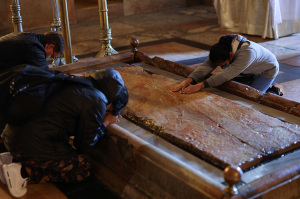Did Jesus Really Sweat Blood the Night Before His Crucifixion?
Did Jesus Christ really sweat blood the night before his Crucifixion as he struggled with the prospect of His torture and death?
Atheist-turned-Christian Lee Strobel had been hesitant to accept this concept while a non-believer, recently telling The Christian Post, "I thought this was hyperbole or legend. Certainly people don't actually sweat blood!"
Strobel's desire to verify the claim led him to consult an expert on the Crucifixion, Dr. Alexander Metherell, MD, PhD.
Strobel says that there was no shortage of skeptics who shared his sentiments. "Here's where skeptics have a field day," he writes in his newly revised book The Case for Christ. "The gospels tell us He (Jesus) began to sweat blood at this point. Now, c'mon, isn't that just a product of some overactive imaginations? Doesn't that call into question the accuracy of the gospel writers?" he asks in his book.

"Not at all," says Dr. Metherell.
The doctor sets the scene of the night before the Crucifixion. "It began after the Last Supper. Jesus went with his disciples to the Mount of Olives — specifically, to the Garden of Gethsemane. And there, if you remember, he prayed all night. Now during that process he was anticipating the coming events of the next day," Dr. Metherell says in Strobel's book.
"Since He knew the amount of suffering He was going to have to endure, He was quite naturally experiencing a great deal of psychological stress," says Metherell, who further reveals that sweating blood really does occur — and it has a name: hematidrosis.
"It's not very common ... What happens is that severe anxiety causes the relase of chemicals that break down the capillaries in the sweat glands. As a result, there's a small amount of bleeding into these glands and the sweat comes out tinged with blood."
Metherell adds, "We're not talking about a lot of blood; it's just a very, very small amount."
Strobel tells CP that Metherell said the hematidrosis would have caused Christ's skin to become "extremely fragile," so that when He was flogged the following day, his skin would have been very sensitive.
Strobel writes in the book, "I braced myself for the grim images I knew were about to flood my mind ... there was something especially unnerving in hearing about someone being intentionally brutalized by executioners determined to extract maximum suffering."
Metherell goes into great detail of exactly how Roman floggings are carried out. "They usually consisted of thirty-nine lashes but frequently were a lot more than that, depending on the mood of the soldier applying the blows."
"The soldier would use a whip of braided leather thongs with metal balls woven into them. When the whip would strike the flesh, these balls would cause deep bruises or contusions, which would break open with further blows. And the whip had pieces of sharp bone as well, which would cut the flesh severely."
The expert adds, "The back would be so shredded that part of the spine was sometimes exposed by the deep, deep cuts. The whipping would have gone all the way from the shoulders down to the back, the buttocks, and the back of the legs. It was just terrible."
Metherell goes on to explain that as the flogging continued lacerations would rip down to the very skeletal muscles.
Enlightened by what he learned from Dr. Metherell, Strobel tells The Christian Post that he did a little digging and found that The Journal of Medicine has analyzed 76 cases of hematidrosis.




























